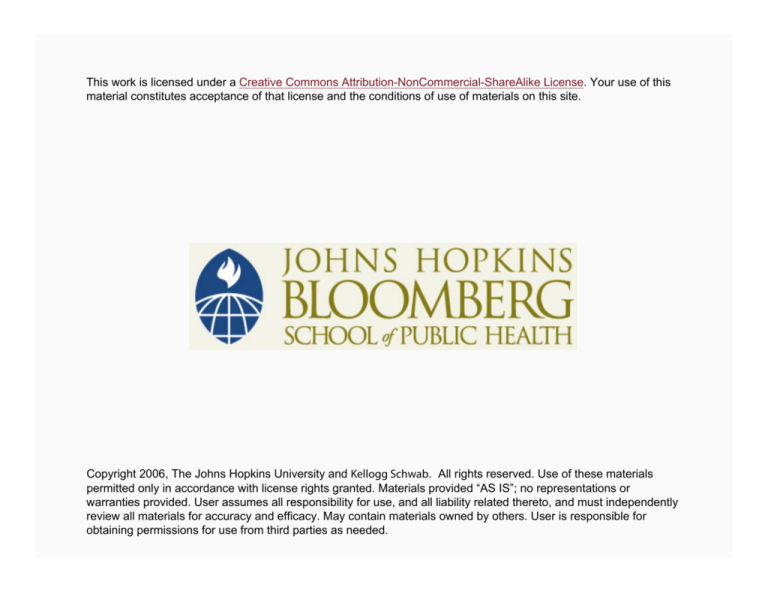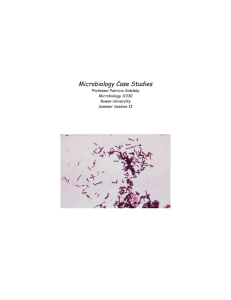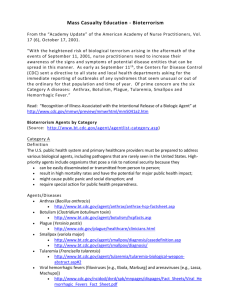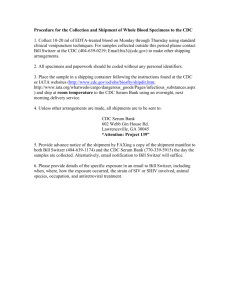
This work is licensed under a Creative Commons Attribution-NonCommercial-ShareAlike License. Your use of this
material constitutes acceptance of that license and the conditions of use of materials on this site.
Copyright 2006, The Johns Hopkins University and Kellogg Schwab. All rights reserved. Use of these materials
permitted only in accordance with license rights granted. Materials provided “AS IS”; no representations or
warranties provided. User assumes all responsibility for use, and all liability related thereto, and must independently
review all materials for accuracy and efficacy. May contain materials owned by others. User is responsible for
obtaining permissions for use from third parties as needed.
Part 4 of 5
Food and Waterborne Microbial Threats
Question
Why are specific microorganisms potential threats to our
drinking water and food?
To address this we need to divide the microorganisms into
categories
Groups of Microorganisms
Bacteria
Parasites
Viruses
Helminths
Prions
Two key concepts to keep in mind
− Size of the microorganism
− Resistance to environmental degradation and chemical
inactivation
Relative Sizes of Pathogens
Red blood cell = 7 microns
E. Coli = 0.5 – 2 microns
Cryptosporidium = 3 microns
Norwalk virus = 0.03 microns
How Small is Small???
A cryptosporidium is ~ 3 microns (µm) in length
− 100 centimeters = 1 meter
− 1,000 millimeters = 1 meter
− 1,000,000 micrometers = 1 meter
− 1,000,000,000 nanometers = 1 meter
You could place 30,000 Cryptosporidium or 50,000,000
noroviruses on the head of a pin!!
Web Site
To see more about the relative size of cells, go to:
− http://www.cellsalive.com/howbig.htm
Microorganisms
Microorganism resistance to disinfection and environmental
degradation
Parasites
Prions >
> Viruses >> Bacteria
Helminths
Specific Pathogens
Others have reviewed the individual class A, B and C
pathogens
We will cover the group of food and waterborne pathogens
Salmonella
http://www.cdc.gov/ncidod/dbmd/diseaseinfo/salmonellosis
_t.htm
Source: CDC Public Health Image Library
Salmonella: Organism
Gram-negative, motile, rod-shaped
Can grow aerobically and anaerobically
The Salmonella group consists of resilient microorganisms
that readily adapt to extreme environmental conditions
Although not spore-forming, they are resistant to drying
Can survive at a pH as low as 4.5
May survive for a long time in nutrient poor environment
− 200 days in contaminated soil, 10 months in dust, 5
months in roach and rodent feces, 4 years in dried whole
egg
Shigella
http://www.cdc.gov/ncidod/dbmd/diseaseinfo/shigellosis_t.h
tm
Source: CDC Public Health Image Library
Shigella: Organism
Shigella
− S. dysenteriae, S. flexneri, S. sonnei, S. boydii
Gram-negative, rod-shaped, non-spore forming
Pathogenesis is related to its entero-invasive properties as
well as its production of Shiga toxin
Shigella: Sources of Contamination and Transmission
Highly host-adapted
− Only natural hosts are humans and a few non-human
primates
− Therefore, 99% of all Shigella isolates in US are from
humans
X Route of transmission predominantly traceable to
humans
X Fecal-oral spread
X Large numbers in stool of clinical cases (105 to 108/g
stool)
X Healthy carriers (~102/g stool)
Shigella: Sources of Contamination and Transmission
One of the most communicable causes of bacterial diarrhea
− As few as 10 to 200 viable organisms will produce illness
− Commonly spread in
X Family settings
X Confined populations
− Day care centers
− Prisons
− Residential institutions
− Cruise ships
Escherichia coli O157:H7
http://www.cdc.gov/ncidod/dbmd/diseaseinfo/escherichiacol
i_t.htm
Source: CDC Public Health Image Library
Escherichia coli O157:H7
Eating meat, especially ground beef, that has not been
cooked sufficiently to kill E. coli O157:H7 can cause infection.
Contaminated meat looks and smells normal.
In many instances, very few organisms are required to cause
disease (<10).
Other known sources of infection are consumption of sprouts,
lettuce, salami, unpasteurized milk and juice, and swimming
in or drinking sewage-contaminated water.
Bacteria in diarrheal stools of infected persons can be passed
from one person to another if hygiene or handwashing habits
are inadequate.
Escherichia coli O157:H7 Sequelae
Hemolytic uremic syndrome (HUS): Persons with this illness
have kidney failure and often require dialysis and
transfusions. Some develop chronic kidney failure or
neurologic impairment (e.g., seizures or stroke). Some have
surgery to remove part of the bowel.
Vibrio cholerae
http://www.cdc.gov/ncidod/dbmd/diseaseinfo/cholera_g.ht
m
Source: CDC Public Health Image Library
Cholera
Acute epidemic dehydrating diarrhea
Usually sudden in onset and if not properly treated is fatal in
approximately half of those infected
One of the most dramatic of all diseases
Cholera: Sources of Contamination
Feces from people acutely infected constitute by far the most
important source of infection in cholera epidemics
− Excrete ~ 107 vibrios/ml of rice-water stool with a total
volume of 10 –20 liters /day
X 1011 (100,000,000,000) organisms in 10 liters
Infected crustaceans also a significant source of infection
Cholera: Clinical Syndromes
The severe fluid and electrolyte loss can lead to dehydration
− Bicarbonate and potassium loss
Cardiac arrhythmia and renal failure
Mortality ~60% in untreated patients but <1% in patients
promptly treated with fluids and electrolyte replacement
Cholera will spontaneously resolve after a few days after
symptoms
Cryptosporidium
http://www.cdc.gov/ncidod/dpd/parasites/cryptosporidiosis/
default.htm
Cryptosporidium
Prior to 1976, recognized exclusively as a veterinary pathogen
of young farm animals
Later, was associated with sporadic zoonotic infection in
humans
1982 – linked to disabling sometimes fatal diarrhea in AIDS
patients
1993 – Milwaukee waterborne outbreak
− 403,000 ill
− ~100 deaths
Cryptosporidium parvum
Complex life cycle involving both sexual and asexual stages
Oocysts are spherical or oval, 3-6 microns in size
Cryptosporidium Epidemiology
Worldwide distribution
Wide variety of animal reservoirs
− Mammals, reptiles, fish
Transmission
− Zoonotic spread from animal reservoirs to humans
− Most common: person-to-person spread by fecal-oral and
anal-oral routes
− Potential transmission by food-handlers who are
excreting oocysts
Cryptosporidium Clinical Syndrome
Oocysts are very infectious
3-11 day incubation (average is 7 days)
May result in asymptomatic carriage
Self-limiting in healthy individuals
− Watery diarrhea without blood
− illness lasts 10-14 days
no medical treatment and the disease is self-limiting
Immunocompromised patients
− >50 stools/day with tremendous fluid loss
− Can be sever and last for months
− 10-15% of AIDS patients die of complications related to
cryptosporidiosis
Noroviruses
http://www.cdc.gov/ncidod/dvrd/revb/gastro/norovirusfactsheet.htm
http://www.cdc.gov/ncidod/dpd/healthywater/factsheets/no
rovirus.htm
Norovirus Disease
Gastroenteritis outbreaks associated with diverse settings
including banquets, cruise-ships, schools, military maneuvers,
nursing homes, summer camps, families
Adults, children, elderly
Most common cause of waterborne and foodborne disease
(uncooked shellfish, cake icing, cold food such as salads,
sandwiches)
23 million cases in the US / yr
NoV Illness
Very rapid onset following 8-48 hr incubation
Self limiting, lasting 24-48 hrs
Vomiting and diarrhea most common symptoms
Individuals are highly infectious during illness
High secondary transmission
Clostridium botulinum
http://www.cdc.gov/ncidod/dbmd/diseaseinfo/botulism_t.htm
Source: CDC Public Health Image Library
Clostridium botulinum
Botulism is a rare but serious paralytic illness caused by a
nerve toxin that is produced by the bacterium Clostridium
botulinum
Botulism
Botulism illness is characterized by symmetric, descending
flaccid paralysis of motor and autonomic nerves, always
beginning with the cranial nerves.
Symptoms include
− double vision, blurred vision, drooping eyelids, slurred
speech, difficulty swallowing, dry mouth, and muscle
weakness.
If untreated, illness might progress to cause descending
paralysis of respiratory muscles, arms and legs.
Botulism
All forms of botulism can be fatal and are considered medical
emergencies. Foodborne botulism can be especially
dangerous because many people can be poisoned by eating a
contaminated food.









